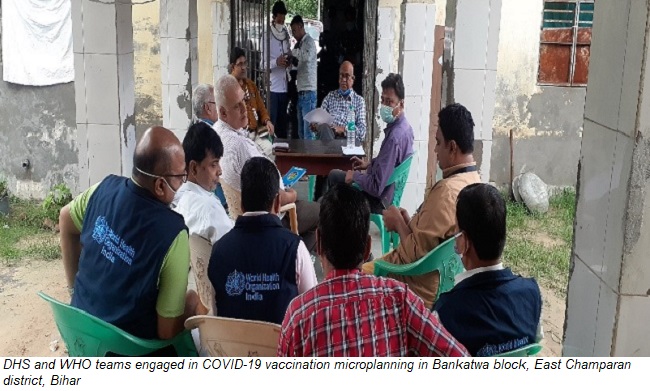The Bankatwa block in East Champaran district of Bihar has become the first block in the state to achieve 95% COVID-19 vaccination coverage for people in the age group of 18-years and above.
This achievement is remarkable because Bankatwa historically has a low routine immunisation coverage of 64.3% due to challenges of difficult terrain, poor health infrastructure and vaccine hesitancy in the community, among others.

Inoculating the eligible population of around 62 000 adults in this hard-to-reach blocks in the district required meticulous operational planning, monitoring, and community participation to address vaccine hesitancy. The district administration collaborated with District Health Society (DHS) and World Health Organization (WHO) field team to undertake an extensive microplanning and monitoring exercise over 2-days with a goal to vaccinate 55 000 registered inhabitants geographically spread across 102 villages and hamlets in eight Bankatwa panchayats.
The Pulse Polio micro-plan and routine immunisation plan served as a guide to prepare the COVID-19 micro plan, with additional operational requirements factored in at the planning stage.
Additional human resources —44 ANMs, 40 data-entry operators — were deployed from neighbouring blocks and district headquarters to operationalise 102 vaccination sites. WHO supported the DHS train 40 data-entry operators for ‘on-the-spot registration’, and community health workers, such as auxiliary nurse midwives and community medical officers, on the management of adverse effects following immunisation.
The vaccine storage capacity of the block was augmented by moving one ice-lined refrigerator from the neighbouring blocks to stock 35 000 doses of COVID-19 vaccines at the primary health centre to ensure timely supply of vaccines to all sites.

Collaborating with local influencers, civil society organisations and religious institutions to endorse vaccination helped to increase coverage. The district administration and health authorities also collaborated with several national and state government programmes, Panchayati Raj Institutions, Public Distribution System, Integrated Child Development Schemes, Bihar Rural Livelihoods Project (JEEViKA) and Booth Level Officers to adopt an individualised grievance redressal model to win community trust. This led to a massive turn-out for vaccination in Sekhuna Panchayat, which had earlier registered a high number of refusals.
The administration established close coordination between the vaccination sites to ensure uninterrupted supply of services. If one site ran out of vaccines, they were sourced from a neighbouring site. Similarly, if one site finished vaccinating all eligible candidates in its catchment area, the site was shifted to another neighbourhood for optimum utilisation of available resources.
As a result, 52 000 of a total population of 62 000 received at least one dose of COVID-19 vaccine in two days, with the 10 000 unvaccinated persons being mostly visitors or people who did not get shots for other reasons, such a pregnancy or recent recovery from COVID-19.
The post-vaccination monitoring activities were led by a WHO surveillance medical officer and field monitors for all 102 sessions in the block. Interviews with 6 572 individuals across 48 hamlets and villages identified 198 unvaccinated persons, most of whom were guests, non-residents and pregnant or lactating women. There were a few refusals and the district administration has plans to organize mop-up rounds to reach those who have been missed.
The success of the ‘Bankatwa Special Activity’ model, as it is popularly known, has showcased how decentralised planning at the block level can bolster vaccine coverage. The state government is now replicating this successful model in other blocks of the districts and beyond.
